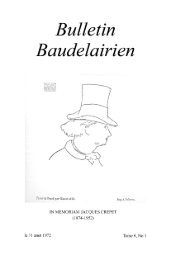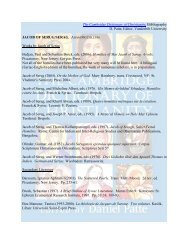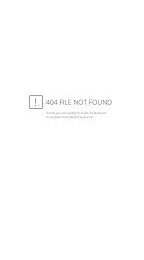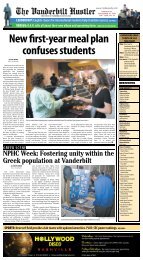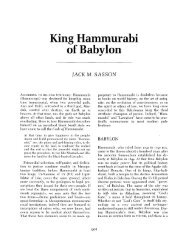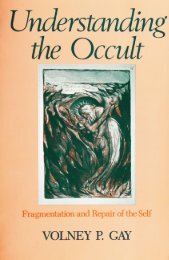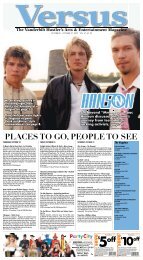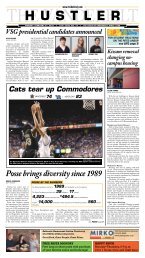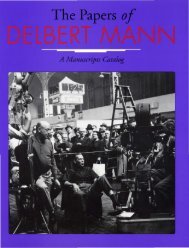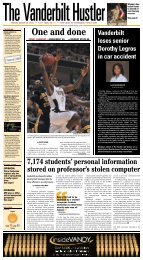From the Editor From the Reader - DiscoverArchive Home ...
From the Editor From the Reader - DiscoverArchive Home ...
From the Editor From the Reader - DiscoverArchive Home ...
Create successful ePaper yourself
Turn your PDF publications into a flip-book with our unique Google optimized e-Paper software.
he unexpectedly found inspiration right on<br />
campus. “A series of events at Vanderbilt led<br />
me to <strong>the</strong> Secrecy Series,” he says, going on to<br />
recount <strong>the</strong> well known and lengthy contretemps<br />
around that time between <strong>the</strong> University and<br />
Don Evans, <strong>the</strong>n associate professor of fine arts.<br />
In one of his photography classes, Evans invited<br />
students to choose, explore and present <strong>the</strong><br />
work of a photographer whose work interested<br />
<strong>the</strong>m. One student chose controversial Robert<br />
Mapplethorpe. Prior to <strong>the</strong> students’ presentation,<br />
Evans warned <strong>the</strong> class some of<br />
<strong>the</strong> images might be offensive, and invited<br />
anyone who thought <strong>the</strong>y might feel<br />
uncomfortable to leave <strong>the</strong> class. No one<br />
did; yet, later a female student in <strong>the</strong> room<br />
reported to <strong>the</strong> dean that she had, in fact,<br />
been offended by <strong>the</strong> photos. That, according<br />
to Aurbach, set in motion a surveillance-type<br />
operation that included students<br />
observing, monitoring and reporting on<br />
Evans to <strong>the</strong> administration. While that<br />
was taking place, a student asked Evans<br />
to show some of his work, which focused<br />
on breast fetishism. Following more complaints,<br />
<strong>the</strong> University charged him with<br />
unintentional sexual harassment. That<br />
accusation so enraged fellow faculty, staff<br />
and some students that 300 people protested<br />
<strong>the</strong> action on <strong>the</strong> steps of Kirkland Hall<br />
and, later, more than 800 attended an<br />
event sponsored by <strong>the</strong> Freedom Forum<br />
to discuss <strong>the</strong> incident.<br />
“Everyone survived it,” Aurbach says<br />
sarcastically. “But I, and many o<strong>the</strong>rs,<br />
never really recovered from it. I have always<br />
wondered since that time if <strong>the</strong>re might be a<br />
student in my class writing a report on me,<br />
monitoring me for <strong>the</strong> administration.”<br />
“The Confessional,” ano<strong>the</strong>r piece in <strong>the</strong><br />
Secrecy Series, is a procession of buttressed<br />
sheet-metal arches, each armed with motiondetector<br />
beeping alarms that are activated as<br />
visitors walk toward <strong>the</strong> priest’s door. On ei<strong>the</strong>r<br />
side of <strong>the</strong>m is a confessional booth, inside of<br />
which are closed-circuit televisions projecting<br />
back one’s own image.<br />
Next came <strong>the</strong> 1998 triptych of relief sculptures<br />
titled “Witness: Conspiracy No. l,”“Witness:<br />
Conspiracy No. 2,”and “Witness: Conspiracy<br />
No. 3.” They all contain <strong>the</strong> tools of surveillance:<br />
headphones, cameras, recorders and<br />
microphones.<br />
“The Institution”(1997), a room-sized interactive<br />
installation, not only is a shot at institutional<br />
secrecy, but a direct hit on Vanderbilt.<br />
Shea<strong>the</strong>d in galvanized steel, <strong>the</strong> triangular<br />
entryway (an upside-down V) is a reproduction<br />
of Vanderbilt’s administration building,<br />
Kirkland Hall. A closer look reveals that it is<br />
also <strong>the</strong> inseam of a man’s pants, <strong>the</strong> patterning<br />
on <strong>the</strong> door a zipper, and <strong>the</strong> metal flap at<br />
<strong>the</strong> top <strong>the</strong> zipper pull. Message boards proclaim:“We<br />
regret any hardships created by this<br />
“The Administrator,”<br />
ano<strong>the</strong>r huge Aurbach<br />
sculpture, measures<br />
8 by 18 by 12 feet.<br />
situation.”“We have no comments at this time.”<br />
“Never reveal your sources.”“Alter personal<br />
files.”“Avoid direct contact with employees.”<br />
If “The Institution”indicted <strong>the</strong> whole, <strong>the</strong>n<br />
“The Administrator”goes after <strong>the</strong> parts, mocking<br />
<strong>the</strong> individuals who hold <strong>the</strong> reins of power<br />
over <strong>the</strong> University. Entry to <strong>the</strong> galvanized<br />
steel-encased office is prohibited by barred<br />
openings and needle-like projections along <strong>the</strong><br />
top.As always, <strong>the</strong> piece brims with visual wordplay<br />
so plentiful <strong>the</strong> viewer always feels he is<br />
missing something. Kneepads are provided for<br />
addressing <strong>the</strong> boss, hoops are available for<br />
jumping through, vacuum cleaners allow for<br />
sucking up, and a lineup of rubber stamps offers<br />
<strong>the</strong> options to tag something “confidential,”<br />
“delay” or “terminate.”<br />
Asked about his relationship with Vander-<br />
bilt, Aurbach responds quickly: “Terrible!” he<br />
laughs. “I’m a social irritant. I get to be like<br />
‘60 Minutes’ used to be: nagging, relentless, irritating.<br />
I’m one of <strong>the</strong> only people in my family<br />
since <strong>the</strong> Bolshevik Revolution to work for<br />
someone else. So it is difficult. I am not against<br />
authority, though; I am against stupidity.”<br />
There is little in <strong>the</strong> academic world that<br />
Aurbach finds more stupid or more irritating<br />
than <strong>the</strong> notion of critical <strong>the</strong>ory, and<br />
that is driving his new work. “The ‘Secrecy<br />
Series’ is morphing into ‘The Critical<br />
Theorist.’ Critical <strong>the</strong>ory is a form of<br />
scholarship that has grabbed hold of<br />
academia, that contends you don’t have<br />
to prove anything. It’s all <strong>the</strong>ory. I have<br />
done three pieces; <strong>the</strong> first used kitchen<br />
equipment because [critical <strong>the</strong>ory] is<br />
all cooked up.”<br />
In order to affect <strong>the</strong> system, Aurbach<br />
is capable of working within <strong>the</strong> system,<br />
as long as it suits him. For many years<br />
he was deeply involved with <strong>the</strong> College<br />
Art Association, with <strong>the</strong> intention of<br />
making sure new teachers understood<br />
expectations, <strong>the</strong> tenure process for art<br />
instructors, how to obtain full professorship,<br />
and how to define national recognition.<br />
<strong>From</strong> 2002 to 2004 he served as<br />
president of <strong>the</strong> CAA, <strong>the</strong> first person<br />
from a Sou<strong>the</strong>rn institution to do so<br />
since Lamar Dodd from <strong>the</strong> University<br />
of Georgia served from 1956 to 1958.“It’s<br />
a big deal,” he says proudly.“In 2006 <strong>the</strong><br />
CAA will host a forum here at Vanderbilt<br />
titled ‘How Far Can You Let Your Students<br />
Go Before You Impinge on <strong>the</strong> First Amendment?’<br />
Considering some of <strong>the</strong> things going<br />
on in Nashville lately, it should be of great<br />
interest.”<br />
Though he believes “Vanderbilt still hasn’t<br />
figured out <strong>the</strong> art thing,” promising developments<br />
are on <strong>the</strong> horizon. Studio art classes,<br />
previously required only for art history majors,<br />
will count for <strong>the</strong> first time as part of <strong>the</strong><br />
core curriculum. The decrepit Cohen Art Building<br />
will be closed, and by early summer a new,<br />
$13 million, 45,000-square-foot Studio Art<br />
Center will open.<br />
“It will be <strong>the</strong> first time I’ve had an office in<br />
18 years, and I will have a studio that is easily<br />
accessible and can accommodate my work.<br />
That new building will add years to my career.”<br />
V a n d e r b i l t M a g a z i n e 31



